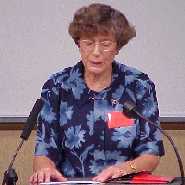
NZFUW President Dorothy Meyer:
Opening Remarks, Introductions |

Maori
Woman of Power
|
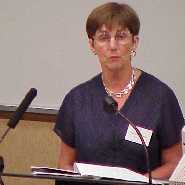
Sylvia Rumball: Conference
Opening
Speaker |
"Educational Pathways to Power"
by
Professor Hilary M. Lips, Ph.D.
1999 Fulbright NZ-U.S. Award Recipient
  
Opening Address: 2000 and Beyond: Women in Education
Mid-Term Council Meeting of the New Zealand Federation of University Women
Copyright © 1999 H. Lips. All rights reserved
February 19, 1999
Hilary M. Lips
~
Department of Psychology
Radford University
Radford, Virginia 24142
|
|
Let
me begin by saying how very pleased and honored I am to be here and
to be a part of the process of looking at the very important issues
surrounding women in education. I offer my thanks to Dorothy Meyer,
who spearheaded this visit, and to all of you for your hospitality.
Two years ago, a young woman in my social
psychology class wrote a short essay in response to my assignment
to write something about "violating a social norm". Here is a portion
of what she wrote:
|
|
During my second semester ... I chose my major as chemistry/Pre-pharmacy,
not realizing that I was going against the "rules" of what men
and women should study. I am young, female, and fairly attractive.
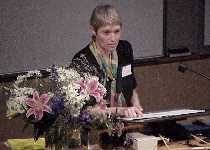 For some reason, people find it amazing that I chose my field
of study, and even hold it against me.
For some reason, people find it amazing that I chose my field
of study, and even hold it against me.
My family expected me to be a teacher
or nurse, ignoring my high ambitions and achievements. They
were amazed when I did well in college math and chemistry, and
found my choice of major distasteful. My grandmother (who refuses
to see a female physician) tried to convince me to change my
major, and tells me that I will never make it to or through
pharmacy school because of my sex.
When complete strangers see me reading
my organic chemistry book where I work, they also find it necessary
to advise me. Comments range from curious ("what made you choose
chemistry?") to anxious ("You, unlike the rest of us, must have
brains") to outright rude ("Someone like you should leave that
stuff to the boys"). One older man even went so far as to tell
me what I, a "pretty young woman" should be studying!
As a result, I have lost pride in my
grades, my future, and my college career. I have, however, found
a way to deal with it. I'm changing my major to nutrition. |
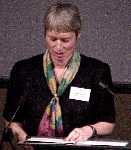 When I read this essay, I was transported uncomfortably back to my
own years as an undergraduate, when I too had been a would-be chemistry
major. During my first year, I remembered, the rector of the science
faculty had systematically called each one of us few female students
into his office for a talk during which he informed us gently that
science was no place for women, and that we should consider changing
to another program. We rebellious young women laughed about this together
later mocking his old-fashioned notions and the very idea that he
would expect us to change our aspirations. Yet not one of us today
has an advanced degree in the natural or physical sciences. We did
not understand then that the cumulative effect of many pessimistic
messages and obstacles would eventually influence each one of us to
take a path that led away from chemistry, physics, mathematics into
fields where we did not always feel we had to defend ourselves.
When I read this essay, I was transported uncomfortably back to my
own years as an undergraduate, when I too had been a would-be chemistry
major. During my first year, I remembered, the rector of the science
faculty had systematically called each one of us few female students
into his office for a talk during which he informed us gently that
science was no place for women, and that we should consider changing
to another program. We rebellious young women laughed about this together
later mocking his old-fashioned notions and the very idea that he
would expect us to change our aspirations. Yet not one of us today
has an advanced degree in the natural or physical sciences. We did
not understand then that the cumulative effect of many pessimistic
messages and obstacles would eventually influence each one of us to
take a path that led away from chemistry, physics, mathematics into
fields where we did not always feel we had to defend ourselves.
Has so very little changed since my own undergraduate
days? Despite the analysis and effort that have been channeled into
the problem of "getting more women in to the science pipeline," do
young women still feel rebuffed by these fields? Do they still feel
they must reject these fields as possible for them? I am going to
show you some data that suggest that indeed they do but first let
me turn the focus to a different set of aspirations.
A couple of years ago, in the first phase
of my research on powerful possible selves, I asked a group of women
students to try to imagine themselves as political leaders and to
describe what they imagined. A number of them were quite emphatic
in their statements about why it was difficult to imagine themselves
in such as position. Here are some of their comments:
|
|
I
have an aversion to it.
It would be a nightmare.
I am not that cruel.
They are all untrustworthy people.
It would make me feel like a failure. |
Obviously, if we are interested in encouraging young women to imagine
themselves in a wide range of possible careers, the physical sciences
are not the only problem. Whenever I listen to my students talk about
their futures, I am struck with the impression that young women and
men are still, with society's "help," constructing different possibilities
for themselves.
So here we are, at a time when access to
education for girls and women is increasingly recognized as a necessary
pathway to economic success, to power and influence over the directions
that our world is taking. We have seen enrollments of women in universities
climb to over 50% of all students in many countries such as Canada,
the United States, Cuba, Nicaragua, Denmark, Estonia, Poland, New
Zealand and Australia, to name just a few (although women make up
far less than half -- more like 20-30% -- of all university students
in many other countries, according to UNESCO statistics). Yet, even
in countries where women have claimed their half of the places in
higher education, female students often continue to be concentrated
in "traditional" feminine disciplines. I believe that we need to attend
to this issue if we want women to reach their potential and to have
their legitimate share of influence in the global community.
I have been engaged for many years in studying
the choices and directions that young women and men at the college
level construct for themselves. Today, I am going to talk about some
research that I have pursued on students' academic self-views. I will
be showing you findings that suggest that gender stereotyping is still
thriving among the university students of today at least in North
America. Then I will discuss the implications of these findings, showing
how the very fields that women apparently feel they must avoid are
the ones that lead to positions of influence in society. Finally,
I will examine some of the reasons behind young women's and men's
different conceptions of possibility for themselves. Academic Self-Views
I have been examining university students's
academic self-views: their sense of what fields they are good at and
enjoy in the academic environment. 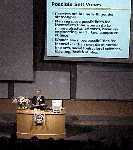 Of course, one of the reasons for the research interest in academic
self-views is that such self-perceptions are assumed to relate to
academic choices and academic achievement. Not only one's views one's
current abilities and interests, but also one's views of what is possible
for oneself may be important in understanding academic choices and
achievement. Theorists propose that each of us has many "possible
selves:" concrete, individual, personalized representations of the
self as it could be in the future (Markus & Nurius, 1986). For example,
I may be able to picture myself as the head of my own business, as
an opera singer, as an award-winning writer, but not as an airline
pilot. That would mean I had possible selves for the first three roles,
but not for the last one. How do we develop possible selves? One way
is through exposure to role models. Thus, for example, some years
ago, many young girls and women in the United States might have developed
a possible self as a political leader when Geraldine Ferraro ran for
vice president.
Of course, one of the reasons for the research interest in academic
self-views is that such self-perceptions are assumed to relate to
academic choices and academic achievement. Not only one's views one's
current abilities and interests, but also one's views of what is possible
for oneself may be important in understanding academic choices and
achievement. Theorists propose that each of us has many "possible
selves:" concrete, individual, personalized representations of the
self as it could be in the future (Markus & Nurius, 1986). For example,
I may be able to picture myself as the head of my own business, as
an opera singer, as an award-winning writer, but not as an airline
pilot. That would mean I had possible selves for the first three roles,
but not for the last one. How do we develop possible selves? One way
is through exposure to role models. Thus, for example, some years
ago, many young girls and women in the United States might have developed
a possible self as a political leader when Geraldine Ferraro ran for
vice president.
What difference might it make to have a particular
possible self? A possible self is thought to have an energizing and
organizing effect on the individual's actions (Markus et al, 1990).
If an individual has a hoped-for possible self, s/he should be motivated
to engage in behaviors that would help to attain that possible self.
For instance, having a hoped-for possible self as, say, a physicist,
would make taking physics courses and studying hard in physics more
important and useful and perhaps even more enjoyable. However, a possible
self apparently does not develop just because someone holds views
of her current abilities that may be consistent with it.
I compared the career aspirations of groups
of young women and men who were high or low on their self-described
inclination toward mathematics and science. Both women and men who
held a view of themselves as currently inclined toward math and science
rated themselves high on the likelihood of a career in mathematics,
statistics or computer science. However, the same positive inclination
toward math and science was linked to a high likelihood of a career
in the physical sciences or engineering only for men. [OVERHEAD: Table
2: Summary of Bifurcation paper, Lips, 1993].
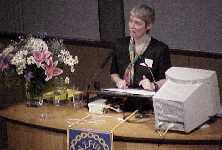 It appears that, despite their current-self
perceptions as positively inclined toward mathematics and science,
the women in this study could not, or would not, construct possible
selves in the realm of engineering and the physical sciences perhaps
because such possible selves were at odds with their notions about
femininity, or perhaps because they had no female role models in these
areas to help them articulate a possible self. Clearly, in the case
of these young women, it would do little good to try to change their
current-self perceptions with respect to math and science. They already
see themselves as good at and interested in these areas. What would
perhaps be useful is finding ways to help these students envision
themselves as physical scientists and engineers to give them the tools
to construct possible selves in these areas.
It appears that, despite their current-self
perceptions as positively inclined toward mathematics and science,
the women in this study could not, or would not, construct possible
selves in the realm of engineering and the physical sciences perhaps
because such possible selves were at odds with their notions about
femininity, or perhaps because they had no female role models in these
areas to help them articulate a possible self. Clearly, in the case
of these young women, it would do little good to try to change their
current-self perceptions with respect to math and science. They already
see themselves as good at and interested in these areas. What would
perhaps be useful is finding ways to help these students envision
themselves as physical scientists and engineers to give them the tools
to construct possible selves in these areas.
The research I am now doing with my students
represents an attempt to better understand the links between current
and possible academic self-views and, eventually, the connections
among these self-views and students' academic choices and performance.
Importantly, it also addresses the question of the role played by
gender-related stereotypes and expectations in these relationships.
Lips Academic Self-View Survey
In this research we have used a questionnaire
called the Lips Academic Self-View Survey (LASS)
consists of three parts.
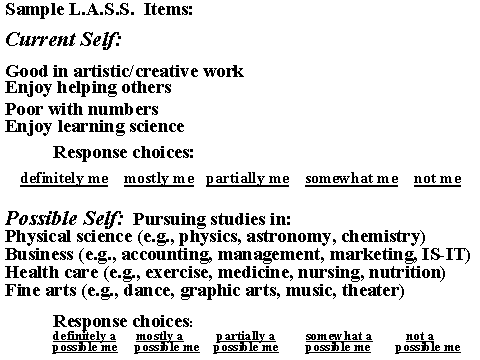 There is a current-self section, containing 30 items relevant to ability
in and enjoyment of activities relevant to academic performance. Each
item is rated on a scale ranging from "not me" to "definitely me."
There is also a possible-self section, consisting of 16 items that
refer to pursuing further studies in particular academic areas. For
each item, the respondent is asked to indicate the extent to which
pursuing further studies in that area is a "possible me," with responses
ranging from "not a possible me" to "definitely a possible me." The
third section of the survey, consists of 10 items that refer to particular
future roles (e.g., successful, widely known writer). We have now
collected data from students at 3 U.S. colleges and 2 Canadian universities.
There is a current-self section, containing 30 items relevant to ability
in and enjoyment of activities relevant to academic performance. Each
item is rated on a scale ranging from "not me" to "definitely me."
There is also a possible-self section, consisting of 16 items that
refer to pursuing further studies in particular academic areas. For
each item, the respondent is asked to indicate the extent to which
pursuing further studies in that area is a "possible me," with responses
ranging from "not a possible me" to "definitely a possible me." The
third section of the survey, consists of 10 items that refer to particular
future roles (e.g., successful, widely known writer). We have now
collected data from students at 3 U.S. colleges and 2 Canadian universities.
Gender and current selves.
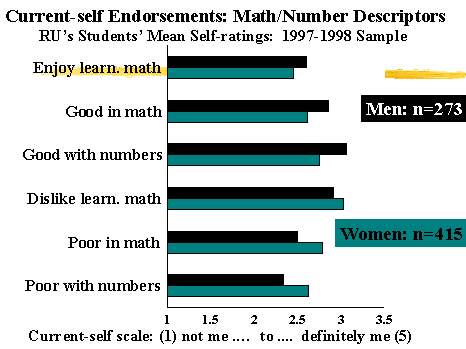 An examination of the individual items on
the current self section of the LASS shows that the patterns are highly
similar and fit the patterns expected for traditional gender stereotypes.
For example, the following graphs show the gendered patterns of self-endorsement
on math/number descriptors for the three samples. [OVERHEADS: Current
self-endorsements: Math/number descriptors; RU;
An examination of the individual items on
the current self section of the LASS shows that the patterns are highly
similar and fit the patterns expected for traditional gender stereotypes.
For example, the following graphs show the gendered patterns of self-endorsement
on math/number descriptors for the three samples. [OVERHEADS: Current
self-endorsements: Math/number descriptors; RU;
ALSO
SEE OVERHEADS of RU Students' Current-self: Science
descriptors,
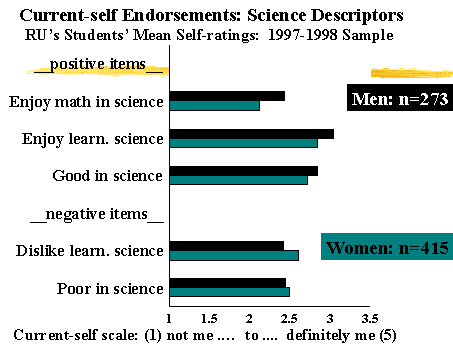
|
and
Current-self: Limited Ability descriptors for
RU Students].
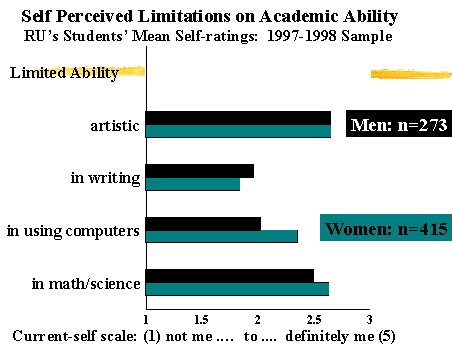
|
Gender and possible selves.
With respect to the possible self items of
the LASS, analyses show that patterns appear to be in line with gender
stereotypes [OVERHEAD: Comparison of women's & men's possible academic
self means -Note Available]. Men assign a stronger possibility than
women do to pursuing further studies in physical sciences (all 3 samples),
business, engineering, math-stats, law, computer science, resource
management (2 samples), and planetary science (1 sample). Women assign
a stronger possibility than men do to pursuing further studies in
fine arts, social behavioral sciences (2 samples), teaching and health
studies (1 sample).
Current self themes and patterns.
[OVERHEAD: Composites of current-self items
- Not Available]. To examine themes and patterns in these data, we
grouped individual items into compositions (or composites) with particular
themes. Time does not allow me to explain in detail how we did this,
but let me just say that we created a Math Composition (encompassing
responses having to do with math and numbers and a Literary/Writing
Composition (encompassing responses having to do with writing), as
well as several other compositions that reflected particular themes.
These proved to be very reliable. We then examined the patterns of
responses by women and men in terms of these dimensions.
The pattern of results is nearly identical
in all three samples that we have studied: In each case men are seen
to score higher on masculine-stereotyped compositions (Math, Science,
Arguing) and women are seen to score higher on feminine-stereotyped
compositions (Literary/Writing, Art, Communication).
Finally, we joined these compositions together
to reflect the two broad themes of academic self-views that differentiated
women and men; the Math-Science Composition (a combination of all
math and science items), and the Literary/Art/Communication Composition
(a combination of all items concerning writing, art, and working with
people). We found that women scored lower on the Math-Science Composite
and higher on the Literary/Art/Communication Composite in every sample.
Clearly there is (still) a broad and reliable
gender difference in the way students view their current academic
selves.
Possible-self themes and patterns.
[OVERHEAD: possible self composites -Not
Available] As we had done with the current self items, we looked at
broad themes in the "possible self" scores. Thus, we constructed compositions
reflecting Natural Science, Business, Humanities, and Social dimensions.
What we found is that women scored higher on the Humanities and Social
composites and men scored higher on the Natural Science and Business
composites.
We then grouped the items even more broadly
to form two dimensions one of which was the encompassed all math-,
science-, computing- and law-related items (which I call the Power
dimension -- for reasons that will later become clear) and the other
of which encompassed all items related to humanities, fine arts, education,
and social-behavioral studies (which I call the People dimension).
Once again, across the 5 samples the women rated themselves more strongly
on the People dimension and men rated themselves more strongly on
the Power dimension.
Relationship between current and possible selves.
Do students' current and possible self-views
relate to each other? To answer this question, we looked at the relationships
between the dimensions that we identified in the students' answers
to the current self and possible self sections of the questionnaire.
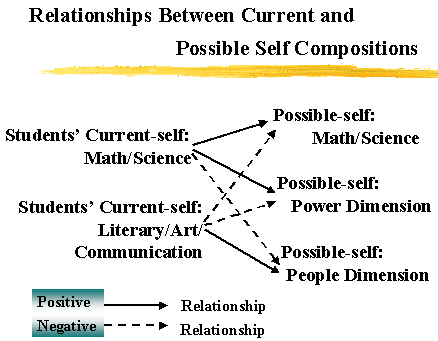 The current self Math/Science dimension was positively associated
with the possible self Math/Science dimension in each of the five
samples; it was also clearly positively linked with the possible self
"Power" dimension in each of the five samples.
The current self Math/Science dimension was positively associated
with the possible self Math/Science dimension in each of the five
samples; it was also clearly positively linked with the possible self
"Power" dimension in each of the five samples.
On the other hand, the current-self Literary/Art
/Communication dimension was negatively related to the same two possible-self
dimensions.
If we focus on the possible-self "People"
dimension, we see that it is significantly negatively associated with
the Math/Science current-self dimension and significantly positively
associated with the Literary/Art/Communication current-self dimension.
Clearly, the students' perceptions of their
current academic selves are linked to their visions of what is possible
for them in the future. Also, very clearly, there is a strong divide
between two groups of academic areas one emphasizing science, numbers,
reasoning and argument, and the other emphasizing culture, people,
and self-expression such that perceiving oneself as oriented toward
one group is strongly and reliably negatively associated with perceiving
oneself as oriented toward the other. And this divide parallels gender
stereotypes. [OVERHEAD: Current self & possible self composite streams]
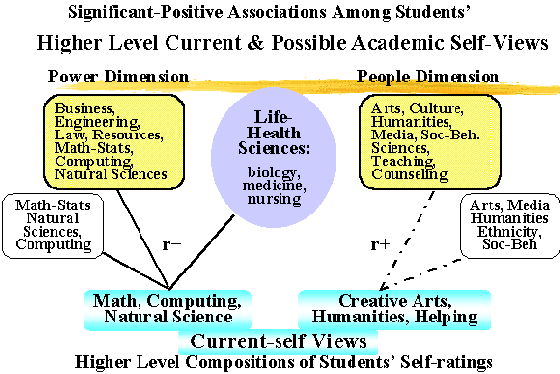
Implications
It appears that the genders differ in their
academic self-construals, particularly with respect to possible selves,
and that the differences parallel traditional gender stereotypes.
Moreover, the two genders differ in ways
that propel them systematically along differing career paths. 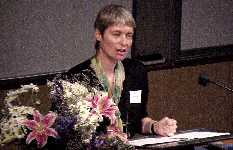 Women
are on paths to teaching, health care, social science, fine arts;
while men are on paths that will lead to careers in science, business,
engineering, law. Women
are on paths to teaching, health care, social science, fine arts;
while men are on paths that will lead to careers in science, business,
engineering, law.
What, really, is the problem? Why does it
matter if women and men are using higher education as a gateway to
different career paths?
It matters because these gender-differentiated
career paths differ in the way they lead, or do not lead, to positions
of power and influence. It is not simply that women are excluded from
the upper echelons of science when they follow these paths, but that
they are also excluded from a wide variety of positions in which they
could make a difference, gain a better share of resources, use their
influence to help other women.
Let us look at political leadership, for
example. What is the educational background of the average person
who holds political office?
To take one example: Three-quarters of the
members of the U.S. Congress come from careers in banking, business
or law. Lawyers, while comprising only 0.1 percent of the workforce,
made up 45.6 percent of the members of Congress in 1993 (Canon, 1995).
Careers in agriculture and engineering are also significantly represented
(Orenstein, Mann, Malbin, & Bibby, 1993). Careers in which women specialize,
such as education, are not.
Knowing this, we went to our possible self
data and constructed a "Politician" composition, made up of these
very themes: the possibilities of pursuing further study in business,
law, engineering and renewable resources (which includes agriculture).
Men's average possible-self ratings for each of these individual domains
is higher than women's, and men's ratings are significantly higher
than women's for the Politician composition in all samples. [OVERHEAD:
Common gateways to political leadership].
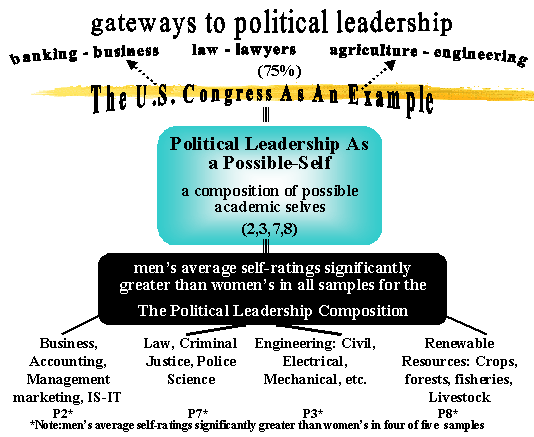
We can do a similar examination of the careers
of individuals who are the CEO's of Fortune 500 companies. Most of
these people do not have university degrees in liberal arts, psychology,
music, cultural studies. Most, in fact, have academic backgrounds
in business, economics, engineering, and/or computing.(slide18)
We constructed a possible self CEO composition,
again made up of themes that appear to be related to following a pathway
to a top business career: the possibilities of pursuing further study
in business, mathematics, engineering, computing, and law. [OVERHEAD:
Gateways to corporate CEO leadership]. Men rate themselves higher
than women on all of these individual possible self items. On the
CEO composition that we created, men's self-ratings are significantly
higher than women's.
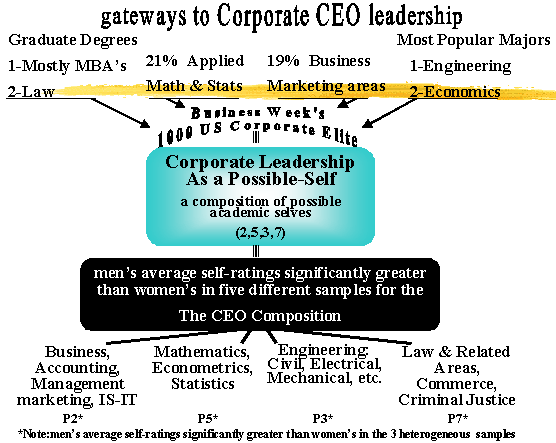
So now perhaps it is clear why I referred
to the possible self dimension that includes the math, science, business,
and law items as the "Power" dimension. Gender is associated with
a set of current-self perceptions which, in turn, are linked to a
set of possible-selves that are gateways to careers with influence
and power. [OVERHEAD: Chart of how it all fits together - not available.
What is making it difficult for women to
imagine themselves in these roles? One obvious factor is a shortage
of women as role models in these areas.
Let's look for a moment at the example of
women in politics. Women have occasionally headed countries as monarchs:
for instance, Queen Elizabeth I and Queen Victoria of England, Catherine
the Great of Russia. However, the first woman elected to lead a nation
appears to have been Sirimavo Bandaranaike, who became prime minister
of what is now Sri Lanka (then called Ceylon) in 1960. From 1960 until
1997, only 31 women around the world were elected or appointed as
heads of state (Neft & Levine, 1997). Now we have a few new ones,
one of which is here in New Zealand[OVERHEAD - HEADS OF STATE, not
available]
With respect to women in business, the picture
is hardly less gloomy. Researchers from Catalyst find that, in the
United States, women make up just 5.3% of line corporate officers
(i.e., roles that traditionally lead to the top executive positions)
and 2.5% of the top earners in Fortune 500 companies. Even among these
top-earning corporate officers, women earn 68 cents in salary and
bonus to every dollar earned by men.
What about women in science? In 1997,UNESCO
initiated the Helena Rubenstein awards for women in science. In order
to identify possible laureates, a study was undertaken over 18 months,
using scientific journals to find the women scientists most often
quoted by their colleagues. Out of more than 54,000 quotes, only 0.17%
(i.e., less than 2 tenths of one percent) mentioned work conducted
by women.
One conclusion I draw from the research I
have been doing and the findings I have discussed today is that it
may be a lot more difficult than we used to assume to make big progress
in recognizing, developing, and employing the talents of women and
men in ways that fairly reflect the distribution of those talents.
All the research I have done speaks to the continuing pervasiveness
of gender stereotypes with respect to competence and the wide array
of forces that operate to keep those stereotypes in place.
I am mindful as well of just how easily such
messages are absorbed. While I was preparing this paper, one of my
departmental colleagues told me the story of his daughter, who, when
in first grade, came home from school one day to announce to her parents
that she was "just average" in math. Concerned, her father asked her
how she had come to this conclusion. It emerged that her teacher had
given a 15-minute test at school, and children whose scores fell in
a certain range had been told that their math ability was "average."
Her father, a psychologist who is well aware of the potential validity
and reliability problems of a single unproven test, tried his best
to dissuade his daughter of the idea that she should accept the teacher's
label for her. However, in the daughter's eyes, the teacher was the
expert, and her father never prevailed. In fact, he said, for the
rest of her elementary and high school education, she continued to
hold the belief that her math abilities were "just average".
In the long run, perhaps the most important
issue here is not simply gender, but the idea that it is important
to keep people from having to close off possibilities for themselves
before they have had a chance to explore them fairly. People may do,
or be encouraged or even forced to do, such closing off because of
their gender, their race, their class, their nationality, their appearance,
or a variety of other characteristics. In many parts of the world,
women and members of various minority groups have been blatantly excluded
from a wide range of possibilities. But simply taking away such obvious
restrictions and barriers is clearly not enough to empower women or
other groups who have been affected by them.
Conclusions
Young women in large numbers will not construct
possible selves as scientists, as political or business leaders, as
holders of high levels of public responsibility, power and influence
just because we tell them it's OK. They must see other women doing
it, doing it well, and not being punished for it by the loss of their
friends and family and the ridicule of the media. When more women
stand in front of university students to teach physics and chemistry
as full professors, when more women"experts" are interviewed respectfully
on television news programs, when more women are elected to political
office, when more women have their creative and scholarly work recognized,
then and only then will young women in significant numbers expand
their sense of possibility. |
Closing
Scenes
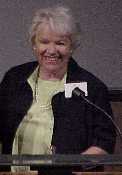 Closing Ceremony Closing Ceremony
and Thank You
By: Molly Mabee |
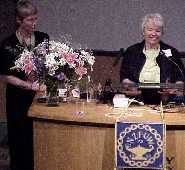
|
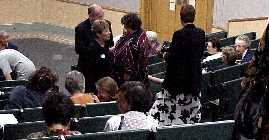
|
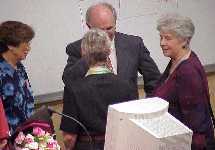
|
|
|




 For some reason, people find it amazing that I chose my field
of study, and even hold it against me.
For some reason, people find it amazing that I chose my field
of study, and even hold it against me. When I read this essay, I was transported uncomfortably back to my
own years as an undergraduate, when I too had been a would-be chemistry
major. During my first year, I remembered, the rector of the science
faculty had systematically called each one of us few female students
into his office for a talk during which he informed us gently that
science was no place for women, and that we should consider changing
to another program. We rebellious young women laughed about this together
later mocking his old-fashioned notions and the very idea that he
would expect us to change our aspirations. Yet not one of us today
has an advanced degree in the natural or physical sciences. We did
not understand then that the cumulative effect of many pessimistic
messages and obstacles would eventually influence each one of us to
take a path that led away from chemistry, physics, mathematics into
fields where we did not always feel we had to defend ourselves.
When I read this essay, I was transported uncomfortably back to my
own years as an undergraduate, when I too had been a would-be chemistry
major. During my first year, I remembered, the rector of the science
faculty had systematically called each one of us few female students
into his office for a talk during which he informed us gently that
science was no place for women, and that we should consider changing
to another program. We rebellious young women laughed about this together
later mocking his old-fashioned notions and the very idea that he
would expect us to change our aspirations. Yet not one of us today
has an advanced degree in the natural or physical sciences. We did
not understand then that the cumulative effect of many pessimistic
messages and obstacles would eventually influence each one of us to
take a path that led away from chemistry, physics, mathematics into
fields where we did not always feel we had to defend ourselves. Of course, one of the reasons for the research interest in academic
self-views is that such self-perceptions are assumed to relate to
academic choices and academic achievement. Not only one's views one's
current abilities and interests, but also one's views of what is possible
for oneself may be important in understanding academic choices and
achievement. Theorists propose that each of us has many "possible
selves:" concrete, individual, personalized representations of the
self as it could be in the future (Markus & Nurius, 1986). For example,
I may be able to picture myself as the head of my own business, as
an opera singer, as an award-winning writer, but not as an airline
pilot. That would mean I had possible selves for the first three roles,
but not for the last one. How do we develop possible selves? One way
is through exposure to role models. Thus, for example, some years
ago, many young girls and women in the United States might have developed
a possible self as a political leader when Geraldine Ferraro ran for
vice president.
Of course, one of the reasons for the research interest in academic
self-views is that such self-perceptions are assumed to relate to
academic choices and academic achievement. Not only one's views one's
current abilities and interests, but also one's views of what is possible
for oneself may be important in understanding academic choices and
achievement. Theorists propose that each of us has many "possible
selves:" concrete, individual, personalized representations of the
self as it could be in the future (Markus & Nurius, 1986). For example,
I may be able to picture myself as the head of my own business, as
an opera singer, as an award-winning writer, but not as an airline
pilot. That would mean I had possible selves for the first three roles,
but not for the last one. How do we develop possible selves? One way
is through exposure to role models. Thus, for example, some years
ago, many young girls and women in the United States might have developed
a possible self as a political leader when Geraldine Ferraro ran for
vice president. It appears that, despite their current-self
perceptions as positively inclined toward mathematics and science,
the women in this study could not, or would not, construct possible
selves in the realm of engineering and the physical sciences perhaps
because such possible selves were at odds with their notions about
femininity, or perhaps because they had no female role models in these
areas to help them articulate a possible self. Clearly, in the case
of these young women, it would do little good to try to change their
current-self perceptions with respect to math and science. They already
see themselves as good at and interested in these areas. What would
perhaps be useful is finding ways to help these students envision
themselves as physical scientists and engineers to give them the tools
to construct possible selves in these areas.
It appears that, despite their current-self
perceptions as positively inclined toward mathematics and science,
the women in this study could not, or would not, construct possible
selves in the realm of engineering and the physical sciences perhaps
because such possible selves were at odds with their notions about
femininity, or perhaps because they had no female role models in these
areas to help them articulate a possible self. Clearly, in the case
of these young women, it would do little good to try to change their
current-self perceptions with respect to math and science. They already
see themselves as good at and interested in these areas. What would
perhaps be useful is finding ways to help these students envision
themselves as physical scientists and engineers to give them the tools
to construct possible selves in these areas. There is a current-self section, containing 30 items relevant to ability
in and enjoyment of activities relevant to academic performance. Each
item is rated on a scale ranging from "not me" to "definitely me."
There is also a possible-self section, consisting of 16 items that
refer to pursuing further studies in particular academic areas. For
each item, the respondent is asked to indicate the extent to which
pursuing further studies in that area is a "possible me," with responses
ranging from "not a possible me" to "definitely a possible me." The
third section of the survey, consists of 10 items that refer to particular
future roles (e.g., successful, widely known writer). We have now
collected data from students at 3 U.S. colleges and 2 Canadian universities.
There is a current-self section, containing 30 items relevant to ability
in and enjoyment of activities relevant to academic performance. Each
item is rated on a scale ranging from "not me" to "definitely me."
There is also a possible-self section, consisting of 16 items that
refer to pursuing further studies in particular academic areas. For
each item, the respondent is asked to indicate the extent to which
pursuing further studies in that area is a "possible me," with responses
ranging from "not a possible me" to "definitely a possible me." The
third section of the survey, consists of 10 items that refer to particular
future roles (e.g., successful, widely known writer). We have now
collected data from students at 3 U.S. colleges and 2 Canadian universities. An examination of the individual items on
the current self section of the LASS shows that the patterns are highly
similar and fit the patterns expected for traditional gender stereotypes.
For example, the following graphs show the gendered patterns of self-endorsement
on math/number descriptors for the three samples. [OVERHEADS: Current
self-endorsements: Math/number descriptors; RU;
An examination of the individual items on
the current self section of the LASS shows that the patterns are highly
similar and fit the patterns expected for traditional gender stereotypes.
For example, the following graphs show the gendered patterns of self-endorsement
on math/number descriptors for the three samples. [OVERHEADS: Current
self-endorsements: Math/number descriptors; RU;

 The current self Math/Science dimension was positively associated
with the possible self Math/Science dimension in each of the five
samples; it was also clearly positively linked with the possible self
"Power" dimension in each of the five samples.
The current self Math/Science dimension was positively associated
with the possible self Math/Science dimension in each of the five
samples; it was also clearly positively linked with the possible self
"Power" dimension in each of the five samples.
 Women
are on paths to teaching, health care, social science, fine arts;
while men are on paths that will lead to careers in science, business,
engineering, law.
Women
are on paths to teaching, health care, social science, fine arts;
while men are on paths that will lead to careers in science, business,
engineering, law.

 Closing Ceremony
Closing Ceremony

